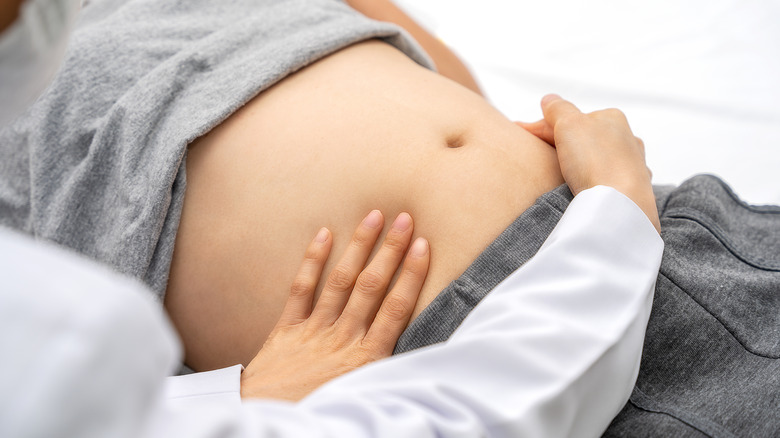Should You Get A Hysterectomy For Endometriosis? The Risks And Benefits, Explained
One in 10 women, according to Yale Medicine, have endometriosis. Endometriosis is when tissue similar to the endometrium that grows inside your uterus begins to grow where it's not supposed to. Typically with endometriosis, that tissue can be found growing on the outside of the uterus, on the fallopian tubes, and on the ovaries, but it can also show up on the bladder, intestines, cervix, and vagina, per Mayo Clinic. That tissue growing in the wrong place can hurt a lot, though not everyone with endometriosis shows symptoms, according to scientific research. For those who do experience symptoms, they can include increased pain and cramping before, during, and after their period, heavier menstrual bleeding, and potential for pain during sex or when you go to the bathroom — particularly on your period. It can also be a contributor to chronic lower back pain and can make it harder to get pregnant. The amount of pain that you experience isn't in direct correlation to how severe your endometriosis is, and sometimes pain from endometriosis may be confused with regular menstrual cramps.
The exact cause of endometriosis isn't known, and there's also no cure for endometriosis, per NIH. But there are ways to treat the symptoms of the condition, including a hysterectomy. Before signing up for such a major and irreversible surgery, here are some things to understand when it comes to the risks and benefits.
Getting an endometriosis diagnosis can take time
To best understand the risks and benefits of a hysterectomy as a treatment for endometriosis, it's important to know the progression of endometriosis from diagnosis through the treatment options that would precede any potential surgery.
The symptoms of endometriosis may be mistaken as having other causes. According to Yale Medicine, women may have endometriosis for 10 years before they get their diagnosis, and when it's left untreated, it can cause organ damage, scarring, and a decreased quality of life. Non-surgical ways to check for endometriosis include an ultrasound, MRI, and a pelvic exam; however, the most definitive way to diagnose endometriosis is with an abdominal surgery where the surgeon will look for the telltale lesions or adhesions, per NIH.
Advocate for yourself with your gynecologist if potential endometriosis symptoms continue to get worse or you've been trying to get pregnant and can't; keeping track of the days you have symptoms can help your doctor see a pattern. Also talk to those in your family to see if they've had it, as research published in the International Journal of Molecular Sciences shows a genetic link. Telling your doctor about a family history of endometriosis could help get a diagnosis.
Hormone therapy and painkillers are the first step
A hysterectomy is not going to be the first thing that your gynecologist will recommend for treating endometriosis. Potential non-surgical therapies include pain medication combined with hormone therapy, as noted by Mayo Clinic. Studies have shown that high levels of estrogen have been tied to the incidence of endometriosis, so medication that can help bring those levels down may help with the pain and the growth of the tissue. One example of a hormone therapy for endometriosis is oral contraceptives, which have been shown to be effective for some women at helping with pain symptoms. But once they stop taking the pills, the pain may return, as reported by the NIH. That's the case with other hormone therapies; pain can recur after the hormone treatment stops.
And for those actively trying to get pregnant, birth control isn't really an option for managing endometriosis. That would also be the case for a hysterectomy, though, and of course taking birth control is reversible while a hysterectomy is not.
More conservative surgery before a hysterectomy may help
A more conservative surgical approach, depending on the spread of the tissue, is to remove the endometriotic lesions, and keep the uterus, ovaries, and fallopian tubes intact. For those with milder endometriosis, scientific research has shown this targeted surgery can also help increase the chances of getting pregnant for those struggling with fertility due to endometriosis.
Dr. Rosanne Kho, OB-GYN, explained at an Endometriosis Foundation of America conference that the more conservative surgery reduced pain symptoms for the majority of patients. But for those patients whose medications weren't helping, who had ongoing pain after a previous surgery to treat endometriosis, and who weren't interested in getting pregnant and giving birth, she said a hysterectomy would be a viable option. Research published in BJOG has shown that a hysterectomy did significantly decrease the pain, and the majority of the women surveyed were happy with the results. So for many women whose pain from endometriosis has resulted in a dramatically decreased quality of life or ability to function day-to-day, a hysterectomy may be well worth it.
There are different types of hysterectomies
Since the tissue may be growing on the outside of the uterus instead of inside, it seems logical that getting rid of the uterus surgically can mean getting rid of pain symptoms from endometriosis. But it's not just a potential decrease in pain after a hysterectomy, there are other important factors to know about the surgery. A hysterectomy, broadly speaking, is surgery to remove your uterus, and it is irreversible. However, there are different types of hysterectomy surgery, and the differences are important.
A supracervical hysterectomy leaves the cervix and ovaries, but not the uterus. A total hysterectomy is the removal of the uterus and cervix, but not the ovaries. A total hysterectomy with bilateral salpingo-oophorectomy removes the fallopian tubes and ovaries along with the uterus and cervix. And finally, the radical hysterectomy with bilateral salpingo-oophorectomy removes everything previously mentioned along with the top part of the vagina, pelvic lymph nodes, and other tissue around the cervix.
Endometriosis can recur after a hysterectomy
With the first two procedures that leave the ovaries intact, if a woman hasn't started menopause yet, it won't automatically start after the surgery, though some menopausal symptoms could occur until the body fully heals, according to UPMC Health Beat. But with the latter two procedures, menopause will begin immediately, aka surgical menopause. There won't be any transition phase into menopause, and this can have an impact on a variety of things, like mood, bone density, and vaginal dryness. And some of the treatments for menopause include hormone replacement therapy, which, as reported by Medical News Today, can cause endometriosis to return after a hysterectomy.
That's a really important factor to consider before a hysterectomy, and one to speak to your doctor about — along with undergoing instant menopause (if you haven't had it yet), the endometriosis can come back. Even without hormone replacement therapy, it may return along with pain symptoms and bleeding. The recurrence was found to be highest for those who had a hysterectomy that kept the ovaries intact and for those with more widespread/deeper endometriosis.
It's not an easy decision to get a hysterectomy to treat endometriosis. Make sure to spend time talking with your medical care team, and work with a doctor you can trust to make the choice that's right for you.





